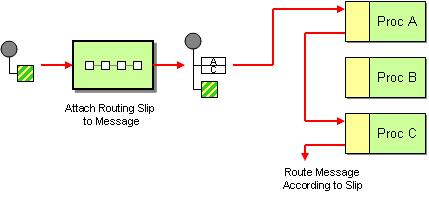Routing Slip
The Routing Slip from the EIP patterns allows you to route a message consecutively through a series of processing steps where the sequence of steps is not known at design time and can vary for each message.

Options
| Div |
|---|
| class | confluenceTableSmall |
|---|
|
Name | Default Value | Description |
|---|
uriDelimiter
| ,
| Delimiter used if the Expression returned multiple endpoints. | ignoreInvalidEndpoints
| false
| If an endpoint URI could not be resolved, should it be ignored. Otherwise, Camel will throw an exception stating the endpoint URI is not valid. | cacheSize
| 1000
| Camel 2.13.1/2.12.4: Allows to configure the cache size for the ProducerCache which caches producers for reuse in the routing slip. The default cache size is 1000. A value of -1 disables the use of the cache. |
|
Example
The following route will take any messages sent to the Apache ActiveMQ queue SomeQueue and pass them into the Routing Slip pattern.
| Code Block |
|---|
|
from("activemq:SomeQueue")
.routingSlip("aRoutingSlipHeader");
|
Messages will be checked for the existence of the aRoutingSlipHeader header. The value of this header should be a comma-delimited list of endpoint URIs you wish the message to be routed to. The Message will be routed in a pipeline fashion, i.e., one after the other. From Camel 2.5 the Routing Slip will set a property, Exchange.SLIP_ENDPOINT, on the Exchange which contains the current endpoint as it advanced though the slip. This allows you to know how far we have processed in the slip.
The Routing Slip will compute the slip beforehand which means, the slip is only computed once. If you need to compute the slip on-the-fly then use the Dynamic Router pattern instead.
Configuration Options
Here we set the header name and the URI delimiter to something different.
Using the Fluent Builders
| Wiki Markup |
|---|
{snippet:id=e3|lang=java|url=camel/trunk/camel-core/src/test/java/org/apache/camel/processor/routingslip/RoutingSlipTest.java} |
Using the Spring XML Extensions| Code Block |
|---|
<camelContext id="buildRoutingSlip" xmlns="http://activemq.apache.org/camel/schema/spring">
<route>
<from uri="direct:c"/>
<routingSlip uriDelimiter="#">
<header>aRoutingSlipHeader</header>
</routingSlip>
</route>
</camelContext>
|
Ignore Invalid Endpoints
Available as of Camel 2.3
The Routing Slip now supports ignoreInvalidEndpoints which the Recipient List also supports. You can use it to skip endpoints which are invalid.
| Code Block |
|---|
|
from("direct:a")
.routingSlip("myHeader")
.ignoreInvalidEndpoints();
|
And in Spring XML its an attribute on the recipient list tag:
| Code Block |
|---|
|
<route>
<from uri="direct:a"/>
<routingSlip ignoreInvalidEndpoints="true"/>
<header>myHeader</header>
</routingSlip>
</route>
|
Then let's say the myHeader contains the following two endpoints direct:foo,xxx:bar. The first endpoint is valid and works. However the second endpoint is invalid and will just be ignored. Camel logs at INFO level, so you can see why the endpoint was invalid.
Expression Support
Available as of Camel 2.4
The Routing Slip now supports to take the expression parameter as the Recipient List does. You can tell Camel the expression that you want to use to get the routing slip.
| Code Block |
|---|
|
from("direct:a")
.routingSlip(header("myHeader"))
.ignoreInvalidEndpoints();
|
And in Spring XML its an attribute on the recipient list tag.
| Code Block |
|---|
|
<route>
<from uri="direct:a"/>
<!--NOTE from Camel 2.4.0, you need to specify the expression element inside of the routingSlip element -->
<routingSlip ignoreInvalidEndpoints="true">
<header>myHeader</header>
</routingSlip>
</route>
|
Further Examples
For further examples of this pattern in use you could look at the routing slip test cases.
| Include Page |
|---|
| Using This Pattern |
|---|
| Using This Pattern |
|---|
|
